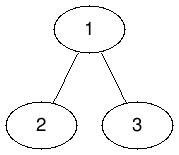CF1370F1 The Hidden Pair (Easy Version)
题目描述
请注意,简单版与困难版的唯一区别在于查询次数的限制。只有在所有版本都被解决后,你才能进行 Hack。
这是一个交互题。
给定一棵包含 $n$ 个节点的树,节点编号为 $1$ 到 $n$。Ayush 和 Ashish 在树中各自选择了两个不同的秘密节点。你需要找出这两个节点。你可以进行如下查询:
- 给出一个节点列表,你将收到该列表中某个节点,该节点到两个隐藏节点的距离之和最小(如果有多个这样的节点,则返回其中任意一个)。你还会得到该节点到两个隐藏节点的距离之和。
回忆一下,树是一个无环连通图。两个节点之间的距离定义为它们之间简单路径上的边数。
更正式地,设两个隐藏节点为 $s$ 和 $f$。每次查询你可以提供树上的一个节点集合 $\{a_1, a_2, \ldots, a_c\}$。作为结果,你会得到两个数 $a_i$ 和 $dist(a_i, s) + dist(a_i, f)$。节点 $a_i$ 是你提供的集合中距离之和最小的节点。
你最多可以进行 $14$ 次查询。
输入格式
第一行包含一个整数 $t$($1 \leq t \leq 10$),表示测试用例的数量。请注意交互过程的组织方式。
每个测试用例的第一行包含一个整数 $n$($2 \le n \le 1000$),表示树的节点数。
接下来的 $n-1$ 行,每行包含两个整数 $u$、$v$($1 \le u, v \le n, u \ne v$),表示树中的一条边。
输出格式
每次查询请输出一行:
- 首先输出 "? c "(不含引号),其中 $c$($1 \leq c \leq n$)表示查询的节点数,接着输出 $c$ 个 $[1, n]$ 范围内的不同整数,表示要查询的节点编号。
对于每次查询,你将收到两个整数 $x$、$d$,其中 $x$ 是你查询集合中距离之和最小的节点,$d$ 是该节点到两个隐藏节点的距离之和。如果查询的节点集合非法或查询次数超过限制,你将收到 $x = d = -1$,此时应立即终止程序。
当你猜出隐藏节点后,输出一行 "! "(不含引号),后接两个 $[1, n]$ 范围内的整数,表示隐藏节点。两个节点顺序不限。
之后,你需要读取一个字符串。如果猜测正确,你会收到字符串 "Correct"。此时继续解决剩余测试用例或全部结束。如果猜测错误,你会收到字符串 "Incorrect",此时应立即终止程序。
猜测隐藏节点不计入查询次数。
交互器是非自适应的。隐藏节点不会因查询而改变。
每个测试用例需在输入下一个测试用例前解决。
每个测试用例最多允许 $14$ 次查询,而不是所有测试用例总共 $14$ 次。
每次输出查询后不要忘记换行并刷新输出,否则会因超时被判为 Idleness limit exceeded。可使用:
- C++:fflush(stdout) 或 cout.flush()
- Java:System.out.flush()
- Pascal:flush(output)
- Python:stdout.flush()
- 其它语言请查阅相关文档。
Hack 格式
如需 Hack,请使用如下输入格式:
第一行包含一个整数 $t$($1 \leq t \leq 10$),表示测试用例数量。接下来是每个测试用例的描述。
每个测试用例第一行包含一个整数 $n$($2 \le n \le 1000$),表示树的节点数。第二行包含两个不同的 $[1, n]$ 范围内的整数,表示隐藏节点。接下来的 $n-1$ 行,每行包含两个整数 $u$、$v$($1 \le u, v \le n, u \ne v$),表示树中的一条边。
说明/提示
下图为第一个测试用例的树结构,隐藏节点为 $1$ 和 $3$。

由 ChatGPT 4.1 翻译